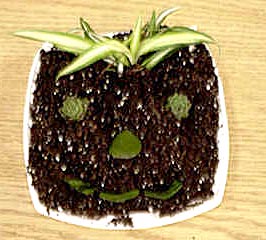|

Pieces of Plants Can Do the Job

|
A shallow container with drainage holes.
(Styrofoam trays that fruit is wrapped in works well.)
This is your laboratory.
Potting soil
A large plastic bag
A variety of plant parts
-
grass or sprout seeds
-
spider plant plantlets
-
onion sets
-
potato tubers
-
ivy
-
jade plant leaves
|
You and Detective LePlant found out how plants can be
grown from seeds. Plants can also be grown from pieces of
plants such as stems, leaves and plantlets.
These are called cuttings.
Plants can also be grown from special plant parts called
bulbs and tubers. To help us find out about the world of
plant propagation,
we will call upon our friend Dr. Plantenstein. He will offer
a number of clues to plant propagation methods.
 Cuttings
need to be placed into something to form roots. You can
use sand, soil mix, or water. Cuttings needs a moist, humid
environment to root. Cuttings
need to be placed into something to form roots. You can
use sand, soil mix, or water. Cuttings needs a moist, humid
environment to root.
Frankenstein was created from different parts. You can
create your own plant monster from different plant parts
and call it Plantenstein.
Try using grass seed or sprout seeds for hair; spider
plant plantlets or other small stem cuttings for eyes;
an onion set for a nose; small cut pieces of potato
tubers for ears; ivy for the mouth; and a jade leaf
for the tongue. You might want to try other things just
to experiment.
On a piece of paper, draw out a plan of how your Plantenstein
face will look. Show where the various plant parts will
be used. Once you have your plan, you're ready to make Plantenstein!
Steps in Making Plantenstein's Face
-
Begin by filling the container with your potting soil.
-
Then following your plan place your different plant
parts where they should be.
-
Moisten the soil in the container and slip it into
the plastic bag. Close it tightly. This will help to
keep the cuttings moist and speed rooting.
-
Check your laboratory daily to make sure there is enough
moisture, but don't overwater. Plantenstein should come
to life in about 2 weeks.
-
Keep a journal of which plants grow rapidly, and what
kind of problems you have.
Once your Plantenstein is alive and
growing, it's time to learn about some other ways to grow
plants from parts...
|



